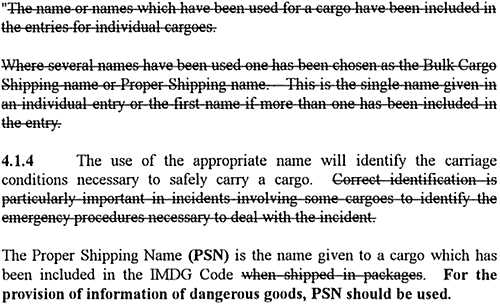The typical liquefaction phenomenon does not take place when one of the following conditions is satisfied:
(1) When the cargo is the materials consisting of very small particles, such as clay, the microscopic movement of the particles is confined by the cohesion;
(2) When the cargo is the materials consisting of large lumps, such as ordinary iron ore, the water in void goes through with small resistance and the pressure of water in void does not increase.
(3) When the void of the material contains much air, in other words, when the moisture content of the cargo is low enough, the air in void goes through with small resistance and the pressure of water in void does not increase.
Therefore, cargoes which may liquefy will contain moisture and at least a proportion of small particles. The cargoes categorized into Group A, including mineral concentrates and certain coals, may liquefy during voyage. The cargoes categorized into Group A also includes other materials having similar physical properties. All known names of mineral concentrates are included in the appendix for entry of each cargo as the cargoes categorized into GROUP "A" but the coverage is not exhaustive. As described above, cargoes which consist entirely of large particles or lumps or are entirely dry will not liquefy.
7.1.3 At a moisture content above that of the transportable moisture limit, shift of cargo may occur as a result of liquefaction. It should be noted that certain cargoes, as identified by the appropriate authorities, are susceptible to rapid moisture migration and may develop a dangerous wet base during a voyage, even if the average cargo moisture content is less than the TML. It is therefore of extreme importance to mariners carrying these cargoes that they have access to good data on the Transportable Moisture Limit (TML) and the moisture content of the particular cargo. Such cargoes should be trimmed reasonably level and loaded as deeply as practicable. It should be noted that cargoes containing much moisture tend to slide at the bottom of the cargo hold when the cargo is shallow in depth and subject to large heel angles.
7.1.4 The major purpose of the sections of this Code dealing with these cargoes is to draw the attention of masters and others to the latent risk of cargo shift and to describe the precautions which are deemed necessary to minimize this risk. Such cargoes may appear to be in a relatively dry granular state when loaded, and yet may contain sufficient moisture to become fluid under the stimulus of compaction and the vibration which occurs during a voyage.
7.1.5 In the resulting viscous fluid state, cargo may flow to one side of the ship with a roll one way but not completely return with a roll the other way. Thus, the ship may progressively reach a dangerous heel and capsize.
7.1.6 To prevent subsequent shifting and also to decrease the effects of oxidation when the material has a predisposition to oxidize, these cargoes should be trimmed reasonably level on completion of loading, irrespective of the stated angle of repose."
Re: Section 8
No comment.
Re: Section 9
(21) New paragraph 9.3
The proposed new paragraph 9.3 should be moved to paragraph 4.1 and paragraph 9.4 should be renumbered. It should be also noted that PSNs should be used for dangerous goods and the usage of BCSNs is recommended for non-dangerous goods. I propose the following descriptions as new paragraph 4.1.4:
